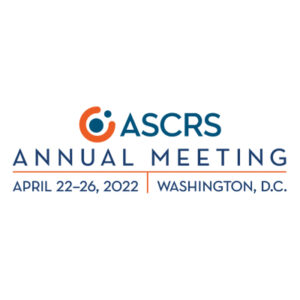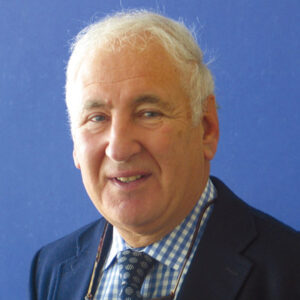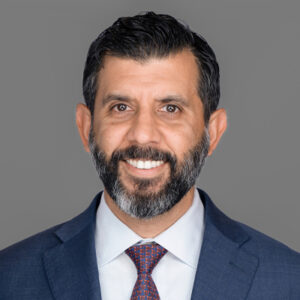ASCRS News
July 2023
by Ellen Stodola
Editorial Co-Director
Marlene Moster, MD, delivered the 2023 Richard L. Lindstrom, MD, Lecture, titled “Glaucoma Surgery: Taking it to the Next Level.” When it comes to glaucoma, Dr. Moster said there are two groups: the “real deal” glaucoma, patients who are going blind, and what she called glaucoma “light,” where they’re not going blind. The MIGS pipeline is robust for mild to moderate glaucoma, but for more severe patients, the options are still trabeculectomy or tubes. She highlighted four problems and new surgical interventions and innovations to improve outcomes.

Source: ASCRS
The first problem she discussed was compliance, saying that many patients don’t take their medicines and don’t understand their medicines. The potential solution she suggested is a new concept in a drug-based delivery system that simultaneously combines cataract surgery and glaucoma medication for a long duration of action (SpyGlass Pharma). Dual pads of drugs are securely placed on the haptics of a monofocal acrylic IOL. Standard phaco is used, and the dual drug pads slowly elute medication for 3 years after surgery, Dr. Moster said. If approved, this new drug-based delivery system would be accessible to all ophthalmologists, including the 75% of cataract surgeons who are not currently utilizing MIGS. Enhanced drug delivery systems such as this will go a long way to alleviate compliance issues and improve patient outcomes, she said.
The next problem that Dr. Moster addressed was intraocular pressure, specifically its fluctuation over time. The potential solution is a surgically placed intraocular pressure sensor (Injectsense) that is capable of 24/7 pressure readings with reliable accuracy. It is meant to be placed in the eye during a 5-minute office procedure and is self-sealing. It is rechargeable once a week and can last decades. Dr. Moster noted that there have been rare complications with minimal immune response. The physician can retrieve IOP data through the cloud to modify treatment. She also mentioned a similar option that is an RFID-powered micro-sensor (Implandata) located in the suprachoroidal space, inserted in combination with phaco, glaucoma surgery, or in a standalone procedure, intended to measure IOP.
Next, Dr. Moster discussed goniotomy. The goal of goniotomy is to open the trabecular meshwork to expose Schlemm’s canal and collector channels and improve aqueous drainage, she said, but goniotomy opens only the anterior wall of Schlemm’s canal. There are a number of goniotomy options available, mostly focused on opening the anterior wall of Schlemm’s canal. “We do not manipulate the back wall,” Dr. Moster said. The surgical solution she shared to raise the bar and push GATT to the next level is the T-Rex Duo (Iantrek), made of nitinol with firm elastic memory. This opens the inner wall and the back wall of Schlemm’s canal. It offers better access to the collector channels to maximize outflow with both walls open.
Last, Dr. Moster discussed her love/hate relationship with tube shunts, suggesting the evolution of potentially changing the material that tube shunts are made of and/or making them thinner. The first new option in development is the VisiPlate (Avisi Technologies), which is ultra-thin and can bend without fracturing. It is made from non-fibrotic materials, and the multichannel design creates outflow redundancy with no hypotony. The surface area maintains the drainage space. Dr. Moster said this is made from the thinnest freestanding material in the world. She also highlighted the Gore GDI concept that is 10 times thinner than current drainage devices. The reservoir is within the plate, cells cannot grow into the reservoir, and it’s very permeable to aqueous.
Cathleen McCabe, MD, gave the cataract presentation. She discussed complex cataract surgery and shared a case of zonulopathy. She noted the importance of having a toolbox for complex cataract surgery. Her patient was a 62-year-old active patient who had a 1-week history of poor vision after being hit in the eye with a tennis ball. The vision fluctuated when the eye moved, and the patient was referred for surgical treatment. No zonules were visible when Dr. McCabe took the patient for surgery, and there was no vitreous. She stressed the importance of figuring out a plan in advance.
She put in a 23-gauge trocar to perform an anterior vitrectomy through the pars plana, but there was nothing to provide countertraction as she was proceeding with capsulotomy. She had iris hooks on hand, which she said are a little more versatile than capsular hooks. You want to think about where the forces are during the capsulotomy and provide countertraction to the force that’s being put on the edge of the capsulorhexis, Dr. McCabe said.
Dr. McCabe described how she used polypropylene suturing in this case, carefully considering the path of the suture when creating a loop through the capsular tension eyelet and anchoring it to the scleral wall. With this technique, she externalized a 30-gauge needle through a paracentesis after passing it through conjunctiva and sclera and into the sulcus. A cut segment of 6-0 polypropylene suture was threaded into the needle lumen, externalized by withdrawing the needle, then treated with low temperature cautery to create a flange. A second needle was passed and the other end of the same piece of suture was externalized to create a belt loop supporting a capsular tension segment that fixated the capsule to the sclera. She performed a limited anterior vitrectomy through the pars plana, implanted an IOL, then slowly adjusted the tension on the sutures by externalizing the sutures to elevate the IOL. “If you’re doing any other polypropylene and belt loops procedures, the slow externalization of sutures is important to position the lens in a planar fashion behind the iris,” she said.
Dr. McCabe offered pearls for polypropylene flanged techniques:
- Cut the suture segment at a bevel.
- Test the suture by passing into the needle outside the eye.
- Make a long tunnel when passing the needle through the sclera.
- Feed the suture into the needle, inside the eye with microforceps, by preplacing into the lumen of the needle and extruding or by externalizing the needle through a paracentesis.
- Push the suture into the eye as you withdraw the needle.
- Make a large “safety” flange initially.
- Slowly externalize more suture to adjust the tension.
- Hold the suture while indenting into the sclera slightly when at the proper tension.
- Cut the suture 1–1.5 mm from the surface to make a small flange.
- Bury the flange into superficial layers of the sclera.
She also emphasized the need to have a special place in the OR to keep instruments for complex cases, review videos with staff, and film and review your own surgeries to refine techniques.
For the cornea presentation, Francis Mah, MD, presented on behalf of Terry Kim, MD, on the topic of ocular surface and cataract surgery. Everyone realizes dry eye is one of the most common ocular conditions that can result in significant symptoms of discomfort and vision loss, Dr. Mah said. The tear film is the first refractive interface.
Tear film irregularities preop and postop can affect and degrade retinal image quality by 20–40% and can cause problems with visual acuity and higher order aberrations, he said.
Dry eye is one of the most common causes of dissatisfaction in surgical patients, Dr. Mah said, and can cause discomfort, visual fluctuations, and increased difficulty with computer use or night driving.
There are many dry eye diagnostics available, and Dr. Mah said treatment has come a long way. There are medications, devices, and different ways of applying medications. There is also a huge pipeline, and industry is forging a path to dry eye treatments, he added. The reason diagnostics are important is there are many dry eye patients, the majority of who may be undiagnosed.
Daniel Chang, MD, gave the refractive presentation in the session, discussing presbyopia correction. At one time, IOLs were simple, he said, and the only thing that mattered was visual quality. Then we wanted to correct presbyopia, so we wanted visual quality but also to improve depth of field. When you increase depth of field, you potentially reduce visual quality and increase dysphotopsia, he said.
Dr. Chang discussed some of the many lens options through the years, but his main focus was the confusing nomenclature that has developed around naming the lenses and what they do. Because of the difficulty of saying and writing “presbyopia-correcting IOLs,” many use “PC IOLs,” “multifocal IOLs,” and “premium IOLs” instead. This ambiguous nomenclature confuses surgeons and patients and has led to a jumble of marketing-driven terminology, he said.
Can there be a better naming scheme? Dr. Chang said there are several contributing factors to a good name. One is a technical component, which is related to the mechanism of action and the depth of focus characteristics. Second is a regulatory component, which is country/region specific. Third is a marketing component, which can drive surgeon acceptance and understanding and patient perception. Of all these factors, what matters most to patients is the depth of focus characteristics, Dr. Chang said, because this correlates directly with their expected functional abilities.
He suggested adopting the term “range of vision IOL” as a descriptive category. The term is broad yet specific, easy to say and write, and even patients can understand the concept. This term could be further expanded to include extended range of vision and full range of vision IOLs, depending on the expected depth of focus characteristics.
About the physicians
Daniel Chang, MD
Cataract and Refractive Surgeon
Empire Eye and Laser Center
Bakersfield, California
Francis Mah, MD
Scripps Clinic
La Jolla, California
Cathleen McCabe, MD
Medical Director
The Eye Associates
Bradenton, Florida
Marlene Moster, MD
Wills Eye Hospital
Philadelphia, Pennsylvania
Relevant disclosures
Chang: Johnson & Johnson Vision
Mah: Alcon, Aldeyra, Allergan, Aperta Biosciences, Azura, Bausch + Lomb, Kiora, Novartis, NuLids, Oyster Point, Sight Sciences, Sun Pharma, Tarsus Pharmaceuticals
McCabe: None
Moster: None
Contact
Chang: dchang@empireeyeandlaser.com
Mah: Mah.Francis@scrippshealth.org
McCabe: cmccabe13@hotmail.com
Moster: marlenemoster@gmail.com



